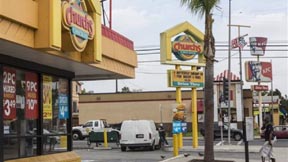 LOS ANGELES: A much-hailed law that restricted the opening of new stand-alone fast-food restaurants in one of the poorest sections of Los Angeles did not curb obesity or improve diets, a new study found.
LOS ANGELES: A much-hailed law that restricted the opening of new stand-alone fast-food restaurants in one of the poorest sections of Los Angeles did not curb obesity or improve diets, a new study found.
City lawmakers passed the zoning ordinance in 2008 that limited the opening or expansion of fast-food outlets in a 32-square-mile area south of Interstate 10 that struggles with high obesity rates and other health problems.
The law, believed to be the first effort of its kind by a major city to improve public health, did not ban new eateries in strip malls.
The research by the Rand Corp. think tank found that obesity rates in South Los Angeles continued to rise after passage of the law.
“It had no meaningful effect,” Rand senior economist Roland Sturm said. “There’s no evidence that diets have improved more in South LA. Obesity and overweight rates have not fallen.”
Health experts said a single intervention would not reverse the obesity problem. People also have to exercise and make lifestyle changes, they said.
“It’s not just about limiting unhealthy food, but increasing access to healthy food,” said Alex Ortega, a professor of public health at the University of California, Los Angeles, who had no role in the study.
Rand researchers reviewed permits issued by the Los Angeles County Department of Public Health, which inspects food outlets. There were no licenses for stand-alone fast-food restaurants, but chains opened 17 new outlets in strip shopping centers and food courts in South Los Angeles from 2008 to 2012.
Almost half of the new food permits were for convenience stores that sell soda and junk food, the study found.
Researchers also compared obesity rates in South Los Angeles and other parts of the county using surveys that asked residents to report their weight and eating habits.
Before the fast-food ordinance, 63 percent of South Los Angeles residents reported being overweight or obese compared to 57 percent in other parts of the county. Three years after the ordinance went into effect, 75 percent of South Los Angeles residents reported being overweight or obese compared to 58 percent in other parts of the county.
Supporters said the ordinance worked because it prevented chains from opening new restaurants at major intersections with their own drive-thru windows and parking lots. They acknowledged it will take some time to see health gains but noted that the area has seen farmers markets and community gardens in recent years.
“We never said this ordinance was the silver bullet” to solving the obesity problem, said Gwen Flynn of the Community Health Councils. “As long as we can make sure people have more options, that’s the important thing.”
City Councilman Bernard Parks, who supported the zoning law, said he was hopeful that the area can attract more markets selling fresh food.
The ordinance was opposed by the California Restaurant Association. Spokeswoman Janna Haynes said the group had no comment on the Rand study.
Standing outside a McDonald’s in the Leimert Park neighborhood, Edward Cox lamented the lack of sidewalk cafes.
“I want to sit down and eat, but there’s no place to sit down and eat,” said the retiree, who usually drives to another neighborhood to dine out.
Cox said he’s hopeful that a planned light rail line will attract a variety of new eateries. -AP






